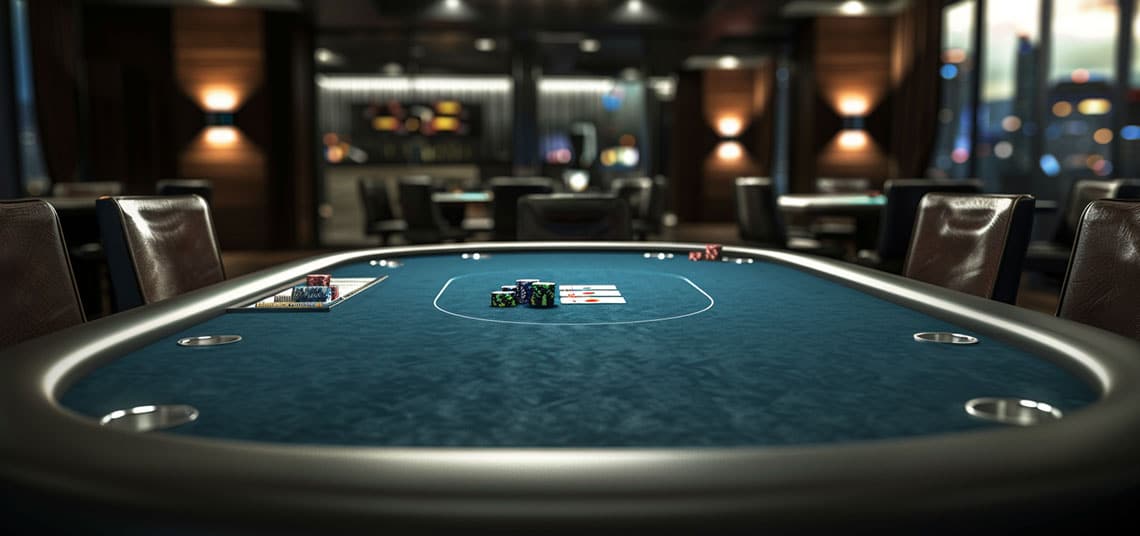No doubt you’ve been there, palms sweaty, heart pounding like a sledgehammer in your chest as you push your chips into the center of the table, delivering the punch line of your well-orchestrated poker face: a bluff. But have you ever heard of the semi-bluff? What’s the deal with this poker jargon?
In the alluring world of poker, semi-bluffing is a strategy that is as intriguing as it is intimidating. A semi-bluff is a bold yet calculated move that relies on your ability to strike the perfect balance between deception and reality. Unlike a pure bluff, where you bet or raise with a hand that has no potential to improve or become the best hand, a semi-bluff involves betting with a hand that might still improve on future cards.
Think of it this way: if poker were a blockbuster movie, a bluff would be the shocking twist that nobody saw coming. On the other hand, a semi-bluff would be that plot build-up, where the suspense mounts, and you’re left on the edge of your seat, anticipating the resolution but not entirely sure what will unfold.
But why is semi-bluffing such an essential strategy in poker? And how can you master this art?

The Intricate Dance of Semi-Bluffing – Why it Matters?
Semi-bluffing is more than just a fancy term tossed around by poker enthusiasts. It’s a well-respected strategy that could transform your poker game if used correctly. But why does it matter? Well, let’s delve into the nitty-gritty of it.
First, by semi-bluffing, you’re essentially playing two games in one hand. On the one hand, you’re hoping to force your opponents to fold, making your semi-bluff effectively a full-bluff. On the other hand, if your semi-bluff is called, you still have outs that could potentially transform your hand into the strongest one at the table. You’re essentially transforming the game into a win-win situation for yourself.
Secondly, semi-bluffing keeps your opponents guessing. The unpredictability of your play can cause your rivals to miscalculate their odds, hesitate in their decisions, and even make costly mistakes. And let’s be honest, isn’t getting inside your opponents’ heads half the fun of poker?
But mastering semi-bluffing isn’t a walk in the park. So how do you become an expert?

Unleashing the Semi-Bluff – The Dos and Don’ts
Now that we’ve built up the suspense and piqued your interest, let’s cut to the chase. How do you semi-bluff effectively? Here are some dos and don’ts:
Dos:
– Choose your opponents wisely: Semi-bluffing works best against players who are known to fold under pressure. Trying this move against loose players who call bets easily might not yield the desired result.
– Evaluate your position at the table: The later you act in a betting round, the more information you have at your disposal. This can be a decisive factor in successfully pulling off a semi-bluff.
– Use semi-bluffs as a deceptive tool: If you’ve established a tight, cautious image at the table, throwing in a semi-bluff can throw your opponents off balance, causing them to question their assumptions about your playstyle.
Don’ts:
– Don’t semi-bluff with weak draws: The better your hand can become, the more reason you have to semi-bluff. Semi-bluffing with weak draws is akin to walking on thin ice.
– Avoid predictable semi-bluffing patterns: If you semi-bluff too often, you’ll quickly become predictable. Remember, variety is the spice of poker life!
So now you know how to semi-bluff. But when is the perfect moment to employ this cunning move?

Striking with Precision – When to Semi-Bluff
Identifying the perfect moment to semi-bluff is an art in itself. But what if I told you there were some tips that could guide your semi-bluffing journey?
First and foremost, consider the texture of the board. In poker, the ‘board’ refers to the community cards that are dealt face-up in the middle of the table. A board with a lot of drawing potential—say, three cards of the same suit or three consecutive cards—presents a fantastic opportunity for a semi-bluff.
Next, always consider your opponents and their betting tendencies. For example, if you are playing against conservative players who are likely to fold unless they have a strong hand, a semi-bluff could be a masterstroke.
Lastly, pay attention to your own table image. If you have been playing cautiously, a sudden semi-bluff could take your opponents by surprise, increasing the likelihood of them folding to your aggressive play.
Now that we’ve explored the why, how, and when of semi-bluffing, let’s wrap things up in a neat, insightful conclusion.
The Semi-Bluff Symphony – Striking the Right Chords
Mastering the art of semi-bluffing in poker is like learning to play a symphony on a grand piano. It requires a fine balance between subtlety and boldness, between patience and aggression. But with practice and the right mindset, it’s a tool that can significantly enhance your poker repertoire.
Semi-bluffing isn’t about getting lucky—it’s about creating opportunities. It’s about adding an extra dimension to your game that leaves your opponents guessing and gives you an edge on the poker battlefield.
With its alluring blend of deception and potential, semi-bluffing is more than just a tactic—it’s a strategic endeavor that can turn the tables, and, if played right, can make the difference between walking away as a victor or vanquished.
Remember, poker isn’t merely a game of chance—it’s a thrilling mind game where strategy, psychology, and skill reign supreme. So the next time you sit at the poker table, remember to weave the art of semi-bluffing into your gameplay, striking the perfect symphony of strategy and unpredictability.
And who knows? With time, practice, and a little bit of that semi-bluffing magic, you might just become the poker maestro you’ve always dreamt of being. After all, in poker, as in life, it’s not just about the cards you’re dealt—it’s about how you play them. Happy semi-bluffing!
GGPoker stands out as a premier online poker destination for players looking to climb the ranks, compete in high-stakes tournaments, or simply enjoy a game of skill. From multi-table poker tournaments to daily cash games, the platform caters to a wide spectrum of players. Ambitious grinders can aim for a WSOP bracelet or WSOP Circuit ring, while newer players can start with free poker games and learn at the GGPoker School. Innovative tools like PokerCraft, Smart HUD, and staking options give every player an edge as they refine strategies, explore new poker formats, and chase big prizes.
